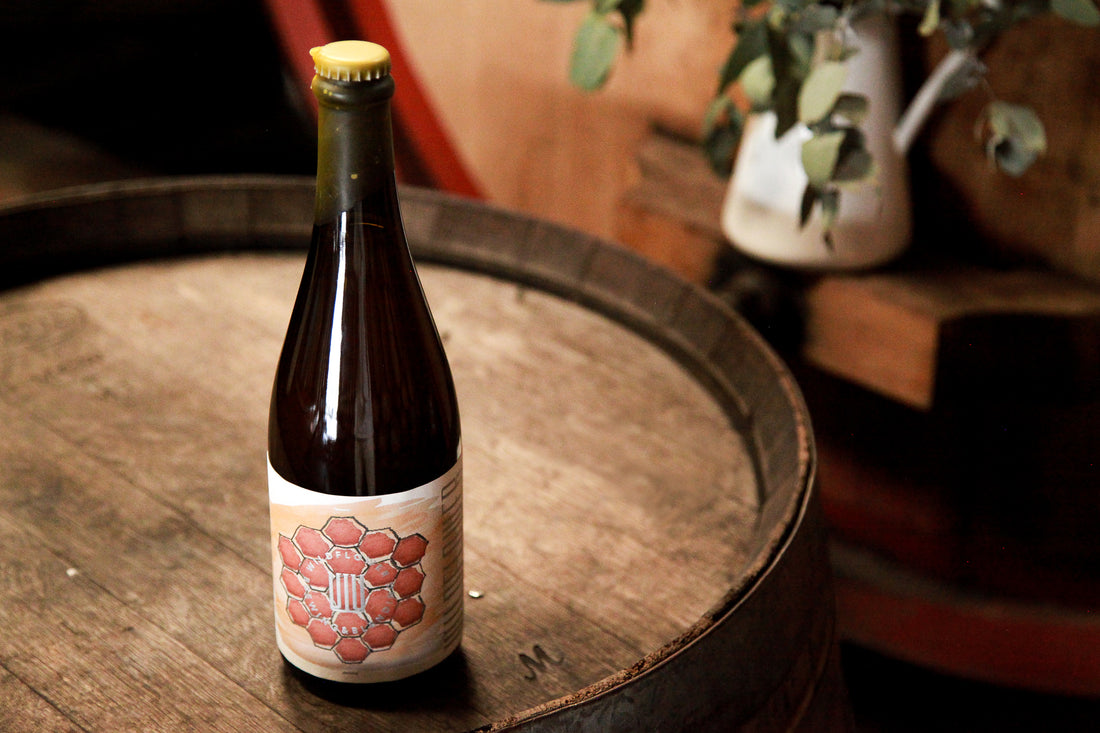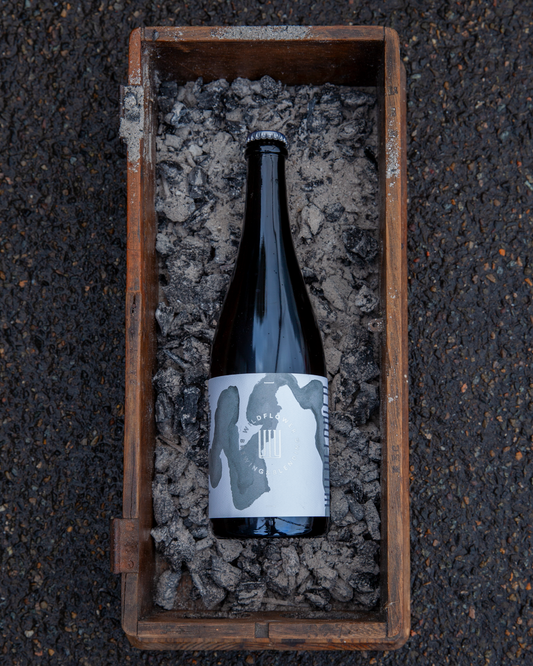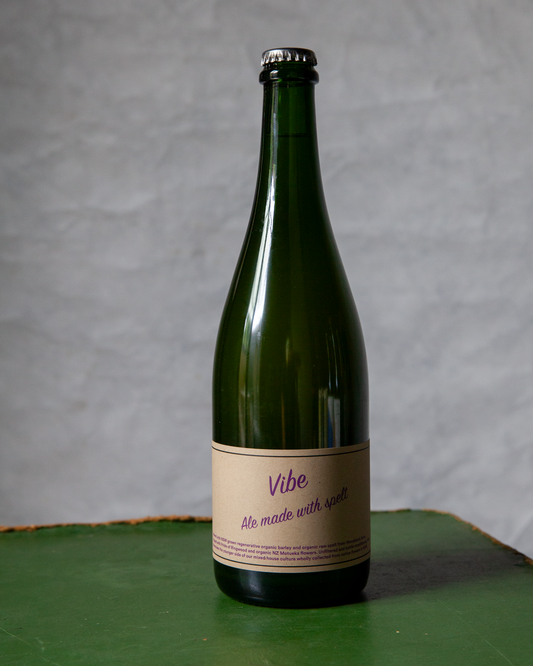We are excited to announce that we will be releasing Hive: Post Brood Blend #1, the first blend of a collaborative project, on Friday March 5th at 12noon Sydney time.
A collaboration with our friends, and honey superstars Tim and Emma from Malfory's Gold honey, Hive: Post Brood is a barrel aged golden Australian Wild Ale refermented with natural formed Warré hive post-brood wild comb from the Blue Mountains and Central Tablelands of NSW. The Malfroy's Post Brood Polyflora is unlike any honey I have ever tasted and indeed a unique product. The beer is our aged Gold refermented and macerated on the left over comb, untreated or heated... just natural, after Tim’s milling and gravity straining of the post brood comb. He doesn’t spin or press the comb, just lets time do its thing. But what happens is that there is still a bit of honey clinging to the waxy comb (along with all the other good propolis, bee bread and pollen). So in September 2020, after much chatting, Tim sent some of that ‘honeywax’ he calls it (the left over comb mixed with honey & others), to us and we employed our hearty yeasts to clean off the comb and ferment any extra goodness on the comb. Old school mead was made this way too, by the comb washings, not from honey dilution. Have a peek below to read Tim's description of Post Brood comb/honey. The beer and the 'honeywax' were left in contact with eachother for one month before bottling. Hive was conditioned in bottle with Tim's honey as well for carbonation. I can give no analogue for the flavours this honeywax (and all the still active microflora) has imparted on our beer. This is an inherently special thing to be a part of though, almost certainly a first, and I am very thankful to Tim for trusting me with this rare gift of nature.

At release this blend is teeming with aromas of bee pollen, resin, bright citrus underpinned by floral undertones. Honey, but not in the way you think... more like bottlebrush nectar, sweet but not cloying. A lot of texture across the palate, again a nourishing feel to it. Lots of body but devoid of excess weight, moreish. If you haven't had the honey, it's a really hard experience to convey... but we cannot lie, there is something intangibly special about this beer... and we'll be the first to say that has way more to do with the honey byproduct and the work of the bees. Each bottle is dipped in the same wax post-refermentation in this beer, there may be small residue still of propolis in the wax leaving black specks in the golden yellow (super aromatic BTW) beeswax.
From Tim Malfroy, 25 February 2021
"Post Brood honey is a term used to describe honey that is produced from combs that have previously contained bee brood.
The honey is a result of the particular style of natural beekeeping we practise, using bee-friendly Warré hives. To begin with, we catch wild swarms of bees in the Blue Mountains to populate the hives. In a wild nest, the comb is a multi-functional living space, built entirely by the bees from wax produced from their own bodies. It can be thought of as the skeleton, skin, womb and liver of the colony, and also acts as a communication network, contributor to social immunity and functions as an extended gut of the colony.

The bees build all their own comb in our hives, and as they expand their nest we give them empty boxes underneath the developing cluster. This is called ‘nadiring’ and is unique to bee-friendly Warré style apiculture. It is the complete opposite of the ‘supering’ approach employed in conventional apiculture, where artificial combs (made of plastic or wax) are given above the broodnest (which is locked in place by a queen excluder) to increase yield.
As the colony grows downwards (as they would in a tree hollow), the queen moves onto the new comb to lay eggs and the combs at the top of the nest which originally contained brood eventually become storage for honey. This re-organisation of the nest is done by the bees themselves, as has occurred for millions of years.
When the colony grows to at least 100L in volume, the top box will contain all honey and no brood - this is genuine surplus honey and can be harvested without causing any harm to the colony. Additional boxes can be ‘nadired’ underneath depending on the time of year and abundance of forage in the environment
The comb at the top of the nest which was originally pure white is now dark purple, coloured with propolis (resin) from years of use. Inside the cells you can see not just honey but the bee bread (pollen fermented by the bees and used to feed the developing brood) containing a multitude of pollen sources. I like to think that you’re not just tasting honey, bee bread and propolis but time too.
Recent research has found over 1,000 different species of beneficial bacteria living in bees and bee bread, an extraordinary number. Interestingly, wild bees – the type that are in our hives - have a broader and healthier spectrum of beneficial bacteria due to being more genetically diverse than the conventionally bred colonies. As we are harvesting and processing whole combs full of bee bread, much of that beneficial bacteria ends up in the honey.
The post brood combs are a result of both entomological (insect) and phytochemical (plant) processes, a perfect marriage of flora and fauna. In addition, the flora of the world heritage listed Blue Mountains, where we produce this honey, is truly remarkable – it’s one of the great wildflower regions of the world with so many unique plant species giving the combs their special qualities.
We gently harvest these post brood combs and mill them to separate the honey from the wax. Because of the age and toughness of the combs – they are up to 5 years old - we use a special machine that we invented to mill them. The entire combs are milled (in conventional beekeeping, the honey from artificial combs is spun out in a centrifuge and re-used). The honey is then bottled into glass jars and quickly sets into a finely crystallised texture due to the high levels of bee bread, propolis and small particles of wax. We then press the honeywax to get the last of the honey out, before washing it in rainwater (the honeywater can be used to make hydromel or mead) and melting what is left down into wax.
This is where Topher and Wildflower come into the picture. This last process of pressing, washing, melting is time-consuming, and yields very little honey and salvageable wax. We’d been talking for a while about how we could collaborate on a project and I thought that adding this post brood ‘honeywax’ to a beer fermentation would be very interesting, as you can taste yeast and sour notes from the fermentation/maturation process that bees use to turn raw pollen into bee bread, and an aniseed/fruitcake spice from the high level of propolis. Topher agreed and had the passion, courage and intelligence to give it a crack.
We were not sure if anyone had ever tried this before, but if they had, it would have been either a few hundred years ago (before the industrialisation of both beekeeping and beer making), or in a traditional culture where these practises still exist. Either way, the process of fermenting the post brood honeywax with the Wildflower house culture has been able to extract the insanely complex plant/insect colony notes from the honey wax and adds incredible dimensions to the beer.
Topher went to impressive lengths to complete every cyclical process, even building a solar wax melter to process the spent honeywax and obtain the beautiful clean yellow beeswax that you see on the caps of the beer.
I’m very proud of what we’ve been able to achieve with this collaboration and am thankful for the opportunity to find the missing piece of the puzzle in our own natural beekeeping production process.
If you’ve read this far, thankyou and I hope you all enjoy the beer!"
Hive: Post Brood is bottled into 750ml bottles and magnum and is 7% ABV. We will have 456 bottles [limit of 4 p/p] and magnums [lim 1p/p] available online on Friday 5 March at noon Sydney time as well as 240 bottles available at cellar door.
We will also be offering a pack of both the beer plus a 200gm jar of Tim and Emma's Post Brood honey both online and at cellar door.
Hive: Post Brood will also see some distribution to our wholesale accounts in Australia and even a little drop in Belgium 😲.





